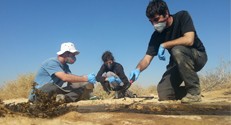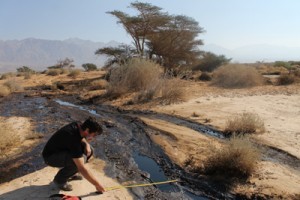Following the Arava Oil Spill: Technion Students in Action
Following the Arava Oil Spill:
A group of Technion students to assist in the restoration efforts of the Arava by treating contaminated soil by biological means (bacteria)
A group of Technion students travelled to the site of the Arava oil spill in order to examine the possibility of restoring land damage by biodegradation – the breakdown of oil through bacteria.
 The Evrona Nature Reserve in the Arava was severely damaged in early December 2014, as a result of an oil pipeline rupture. This event, described as one of the worst ecological disasters in Israel’s history, was caused by a pipeline breach that leaked five million liters of crude oil, which lead to soil contamination and extensive environmental damage. Technion students volunteered to assist in disaster-relief efforts, all of them members of the Ma’alah project (future engineers for the environment).
The Evrona Nature Reserve in the Arava was severely damaged in early December 2014, as a result of an oil pipeline rupture. This event, described as one of the worst ecological disasters in Israel’s history, was caused by a pipeline breach that leaked five million liters of crude oil, which lead to soil contamination and extensive environmental damage. Technion students volunteered to assist in disaster-relief efforts, all of them members of the Ma’alah project (future engineers for the environment).
The Ma’alah project, comprised of over 20 students from different Technion faculties, was founded in January, 2014 in an effort to harness the knowledge gained at the Technion for the betterment of the environment. Young researchers and faculty members from the Environmental, Water and Agricultural Engineering Unit offered to lead the group in the professional aspects of the project. This student initiative is entirely voluntary.
“We reached the affected area and met with people from the Nature and Parks Authority, working to rehabilitate the reserve,” explained uriel klar, a student in the Faculty of Civil and Environmental Engineering. “We were amazed by the intensity of the damage we saw. Rivers in the reserve are still flowing black with numerous oil puddles built up along the shores. Countess animals died as a consequence of the disaster, as well as flora and fauna. This is a photo showing the signs of damage from the spill.”
“Our intention is to restore the land using bacteria capable of digesting oil and thereby reduce the ecological damage. This method has been employed in the past, at major oil spills such as the massive oil spill in the Gulf of Mexico in 2010. We took several soil samples of the contaminated ground and brought them to the lab at the Technion in order to find a natural microbial population in the soil capable of digesting the oil, using biological cultivation methods and advanced equipment. As part of the test we will take into consideration hydrological, geological and ecological parameters in order to produce a computational model to describe the treatment of the soil.”
The students volunteering on this initiative are operating under the guidance of faculty mentors, Prof. Uri Shavit from the Environmental, Water and Agricultural Engineering Unit, and Assoc. Prof. Sima Yaron from the Faculty of Biotechnology and Food Engineering.



